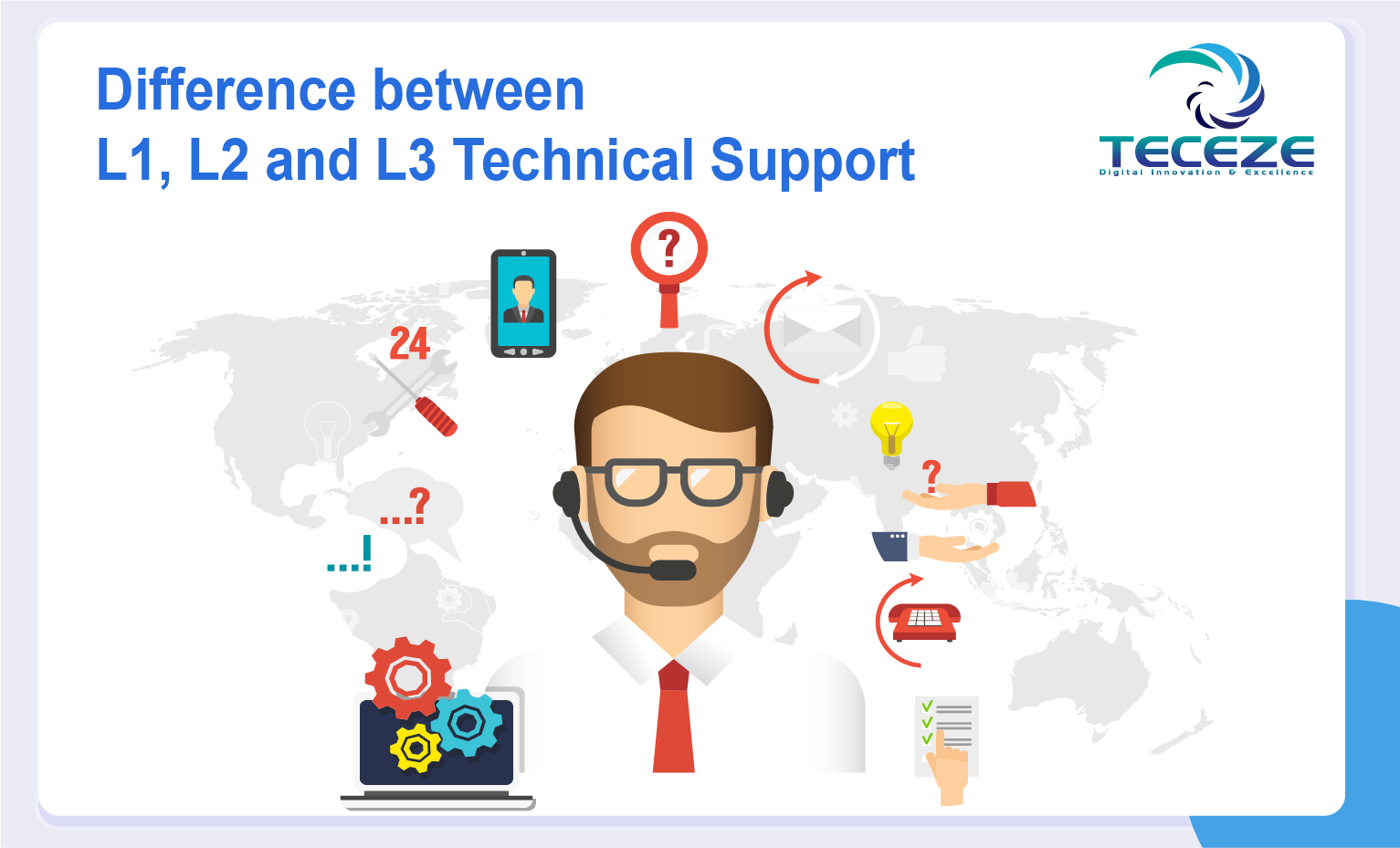Difference Between L1, L2 And L3 Technical Support
Table of Contents
Difference Between l1, l2, l3 Support and Responsibilities
Technical support is a program that assists consumers of technology with goods or services. IT support, help desk, or service desk is also known as technical support. Technical support usually focuses on assisting with a particular user issue or concern, in comparison to conventional training. Technical support also contributes to the general customer service philosophy of an organisation or promotes it, so the team or department can straddle the IT technical world and the practical side of customer service.
For small businesses, technical support may consist of a single employee or may involve several divisions and staff. A big organization such as TECEZE, for example, also has an internal IT support team that supports workers when coping with a technical problem, but an external support team helps clients and device users.
Depending on the service level or tier, technical support can be provided in several ways, including by phone, email, live chat or video, chatbots, online videos, and message boards. There are other logging tools Assistndesk, Salesforce, Any Desk, go to assist, and Freshdesk. These are common third-party applications for help desk support.
L1 Technical Support
This is your first support line. The first line of support is usually provided via chat, phone, and email communications. Your pre-sale support emails and support chats will be addressed by Level 1 technicians. When compared with L2 and L3 level techs, the technical knowledge of L1 techs is limited. They typically deal with problems that can be fixed by the control panels themselves. (Direct Admin etc, cPanel, Plesk).
Help for L1 involves engaging with clients, knowing their challenges, and generating tickets against them. Engineers have basic product/service knowledge and the ability to troubleshoot a very basic problem, such as password reset, installation / uninstall / reinstallation of apps. Help with specific customer problems, such as addressing utilization issues and meeting demands for service desks that require IT participation. Lower-level technical staff are educated by scripts to solve known problems and to satisfy service requests. A ticket will then be redirected to the required L2 support (support for Integration, support for Server & Storage, etc).
If more access or technical skills are needed to fix the problems, depending on the type of problem, then they can typically escalate such cases to L2 or L3 level techs.
L2 Technical Support
Experienced and qualified technicians analyze problems and offer solutions to issues that cannot be addressed by tier 1(L1 engineer). L2 support handles the tickets that L1 routes to them (L2 support can also generate tickets for any problem they notice). They have more skills, and more experience in solving complicated problems relevant to them and can guide/help L1 support people to work in troubleshooting. Level Two technicians have more experience and professional knowledge than L1 technicians. Any of your technical problems that require server backup and access can be solved by them (RDP, SSH etc). These techs can also handle your technical chats without opening tickets and can solve most of the problems through chat. If there are problems that they cannot fix or there are problems that need further access (e.g. node level access), at this stage if the solution is not given, then they typically escalate the cases to L3 tech level.
L3 Technical Support
L3 is the last line of support and typically consists of a development team that deals with technical problems. They are experts in their profession and manage the most c, complex issues. They alter the code, study and improve the solution to challenge new or unknown problems.
L3 techs are masters with years of professional expertise in system management. They can solve almost any problem that needs high technical skills. DC-level structure, network, cloud, and DC level operations can also be controlled. With Level Three Administrators, all high-end system administration tasks are safe. In each moL3-level suggested to have at least one L3 level technology as a team lead. Tier 3 technicians, use product designs, code, or, requirements, strive to replicate issues and identify root causes. L3 support technician has access to problem-solving technological tools for problem-solving or new feature development available. Generally, Tier 3 professionals are the most highly qualified which consists of Chief architects or engineers who designed the service or product.
Teceze – 24/7 IT Support Services
Teceze provides L1, L2 and L3 IT support services to many organizations across the UK and US. OhasT problem-solving skills and has excellent problem solving capabilities. We aim to provide perfect service ice delivery to all our clients. We have required, red resources to handle the first, second and third lines of support. We also maintain a proper tilting system that is user-friendly and is simple to use for our clients. This way, we manage response time to process ourclient'sconcernse or issues. If you are looking for L1 or L2 or L3 support for your business, then contact us right away!
Technical support is a program that assists consumers of technology with goods or services. IT support, help desk, or service desk is also known as technical support. Technical support usually focuses on assisting with a particular user issue or concern, in comparison to conventional training. Technical support also contributes to the general customer service philosophy of an organisation or promotes it, so the team or department can straddle the IT technical world and the practical side of customer service.
 Back to Insights
Back to Insights
 Previous
Previous 